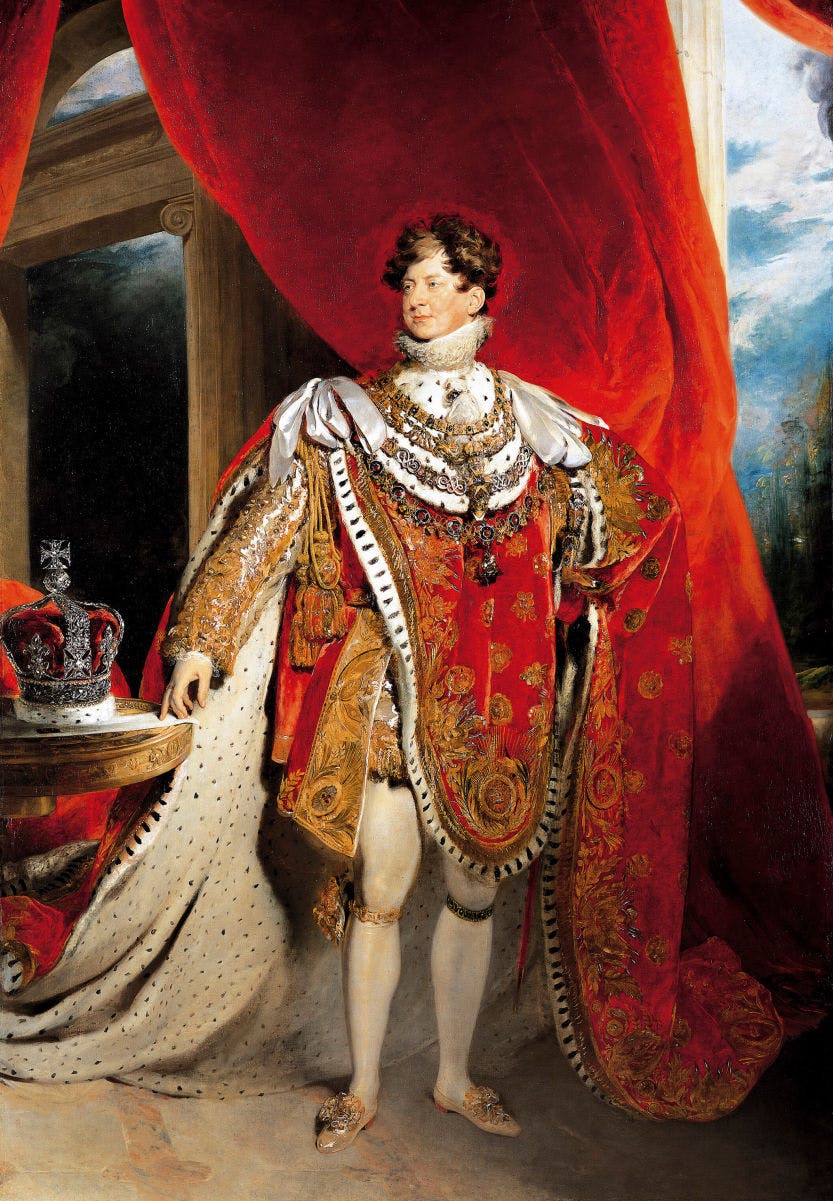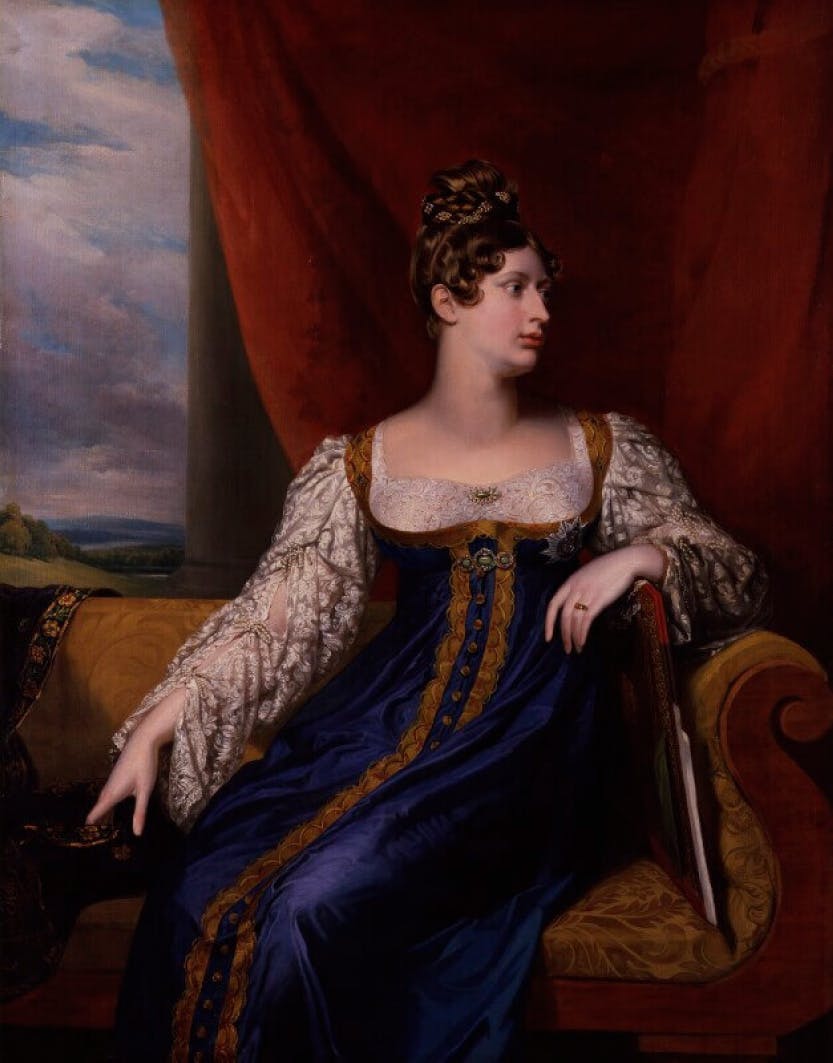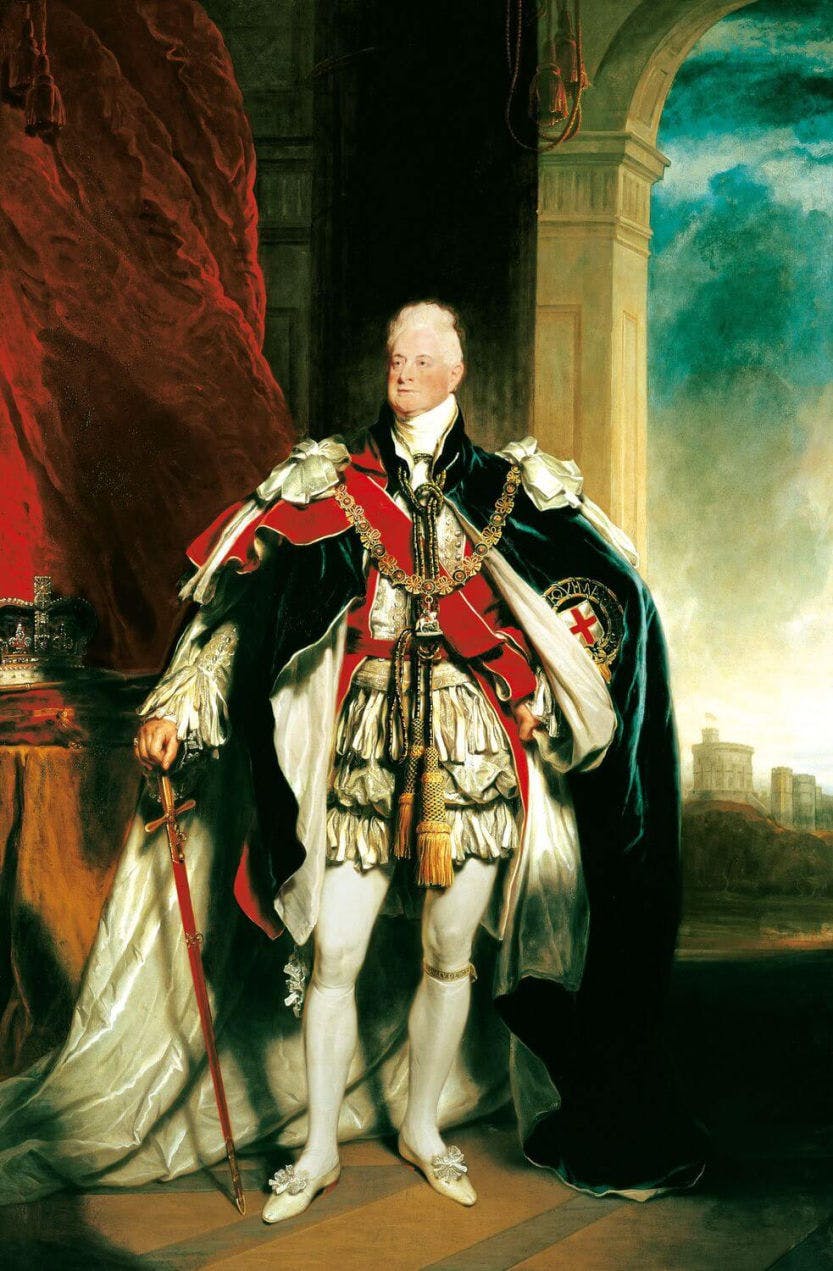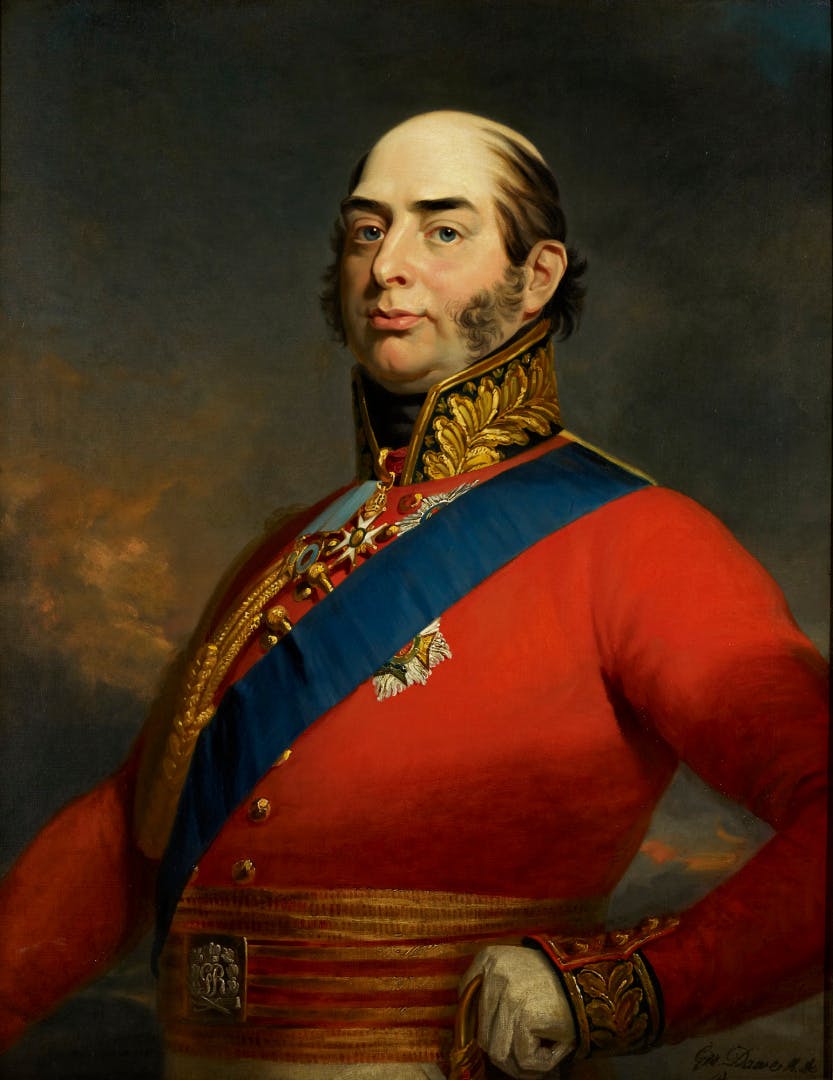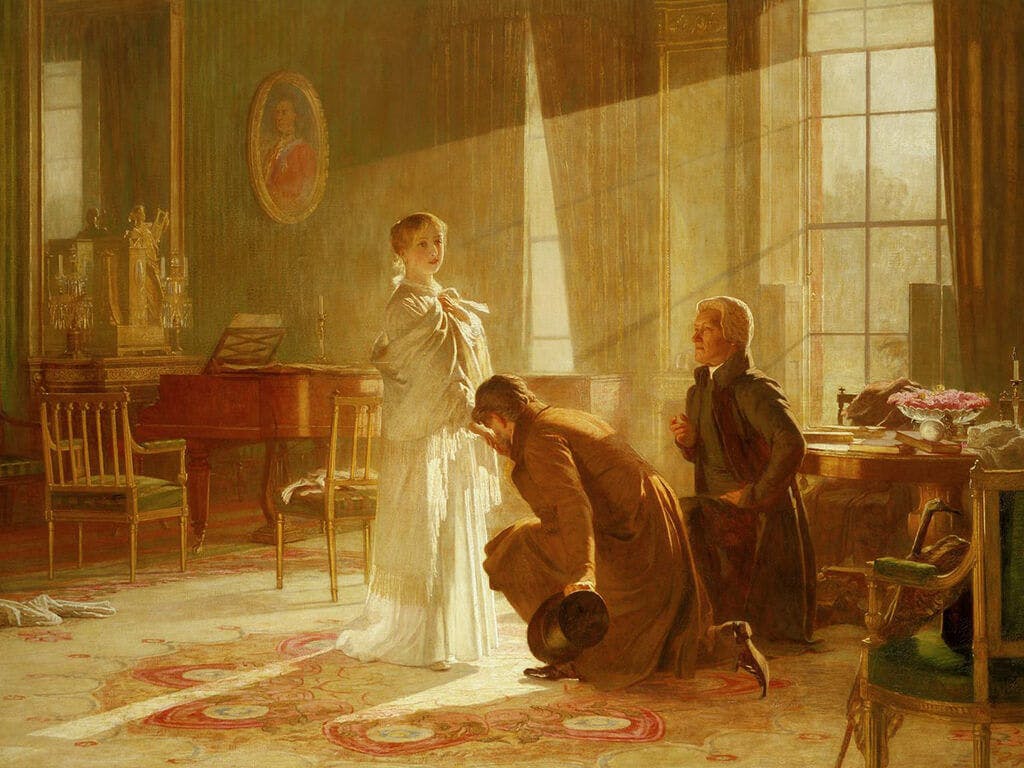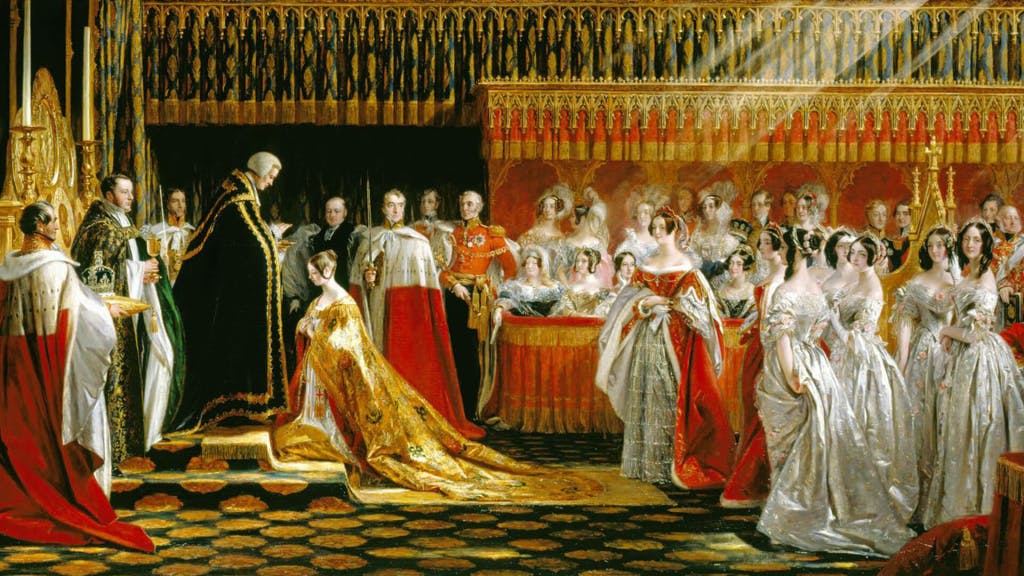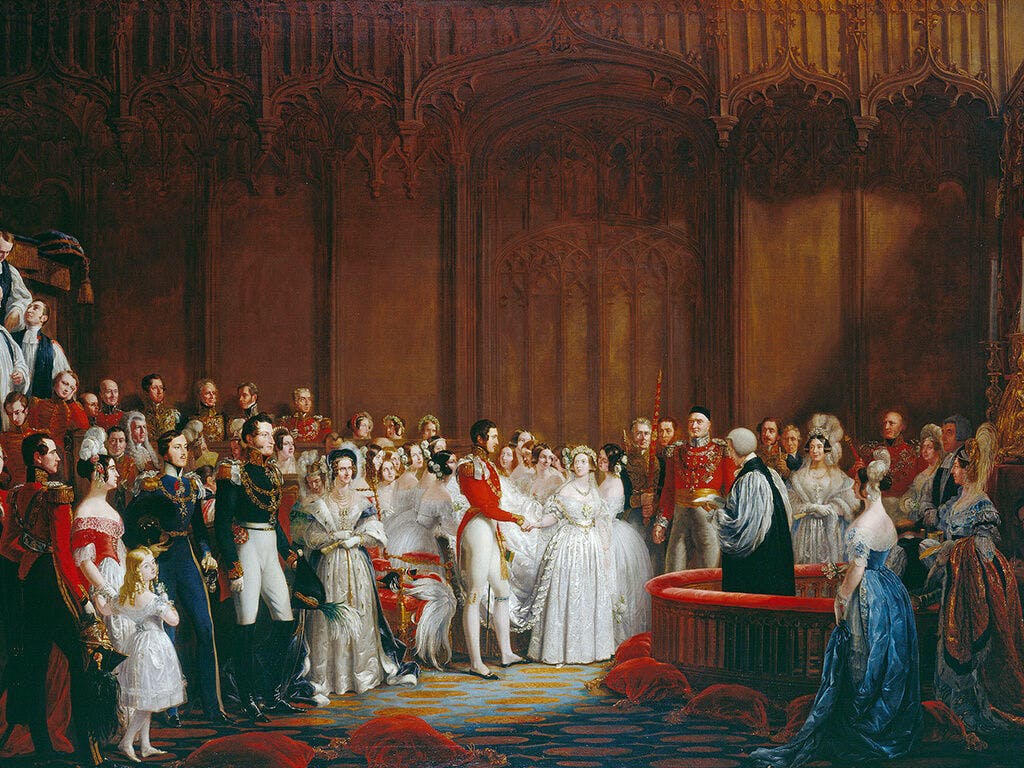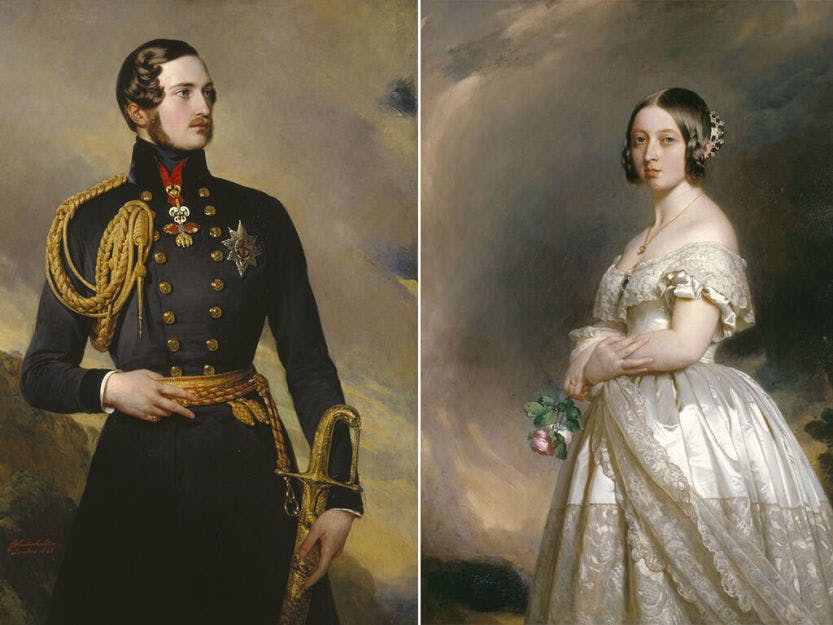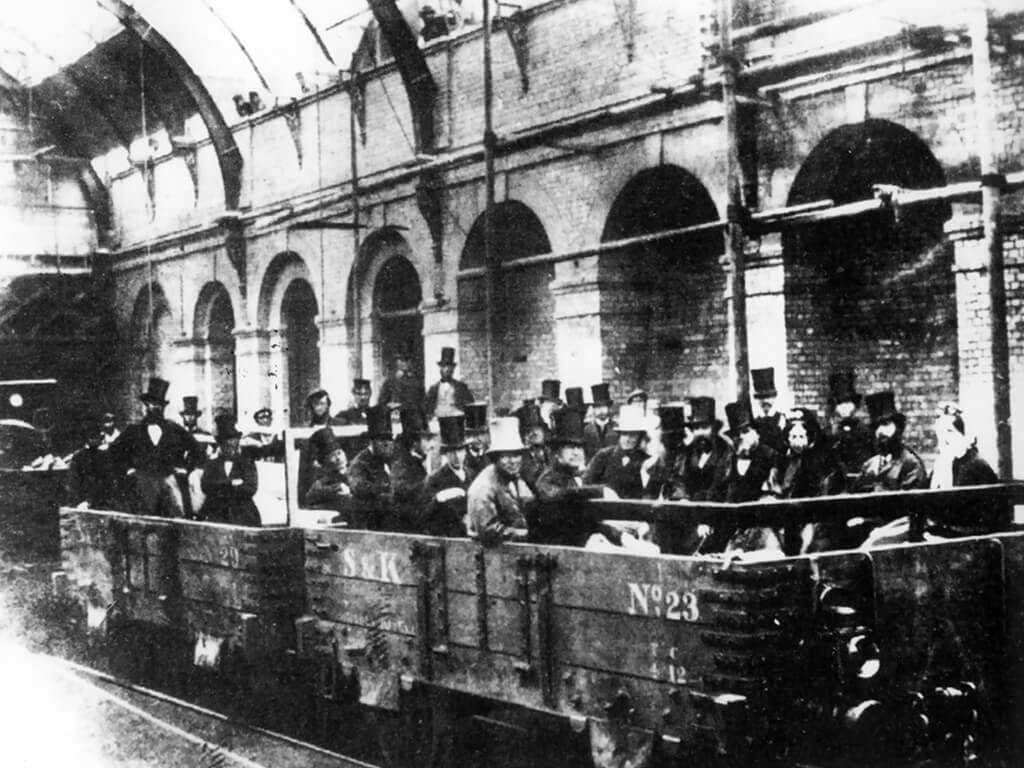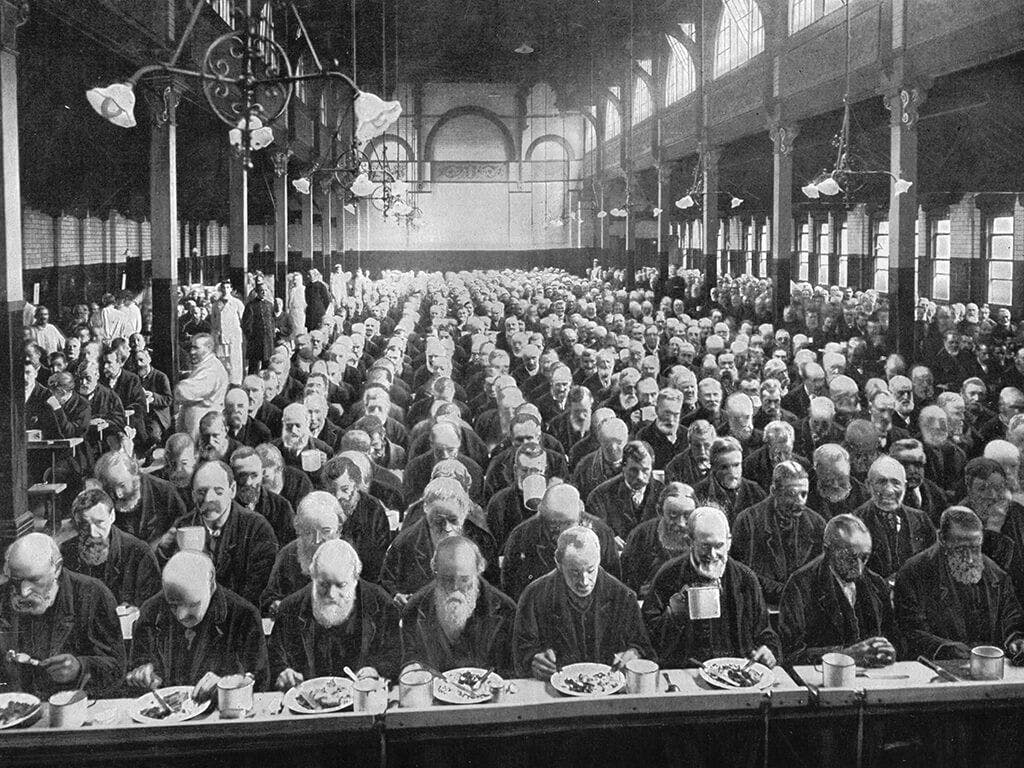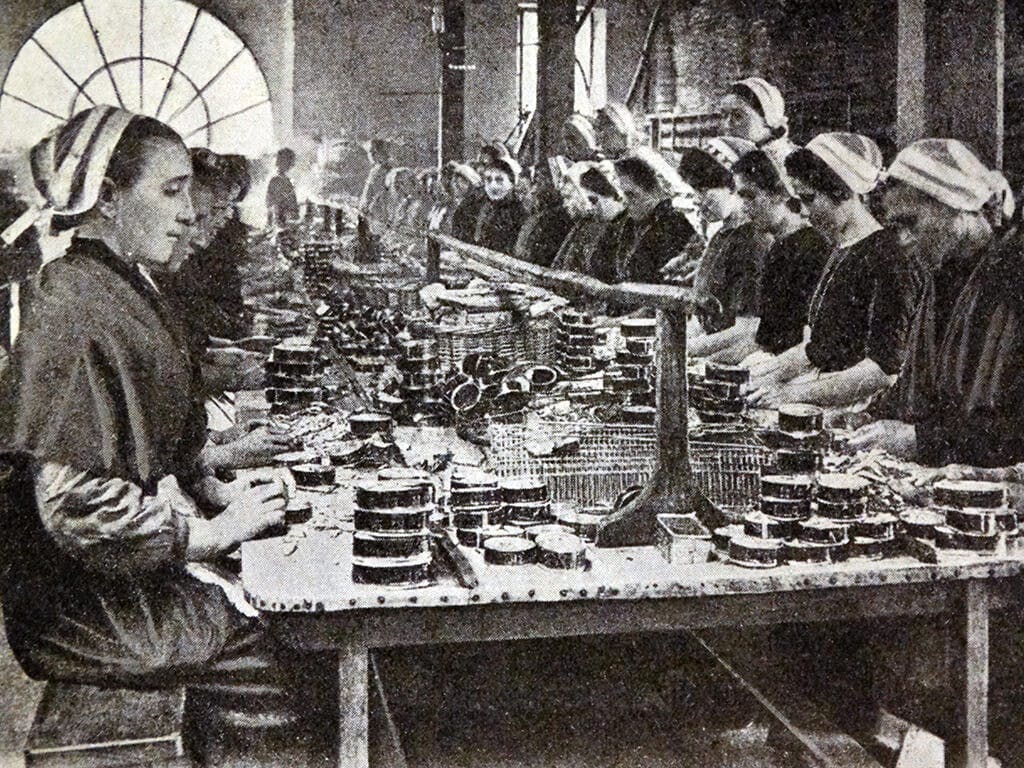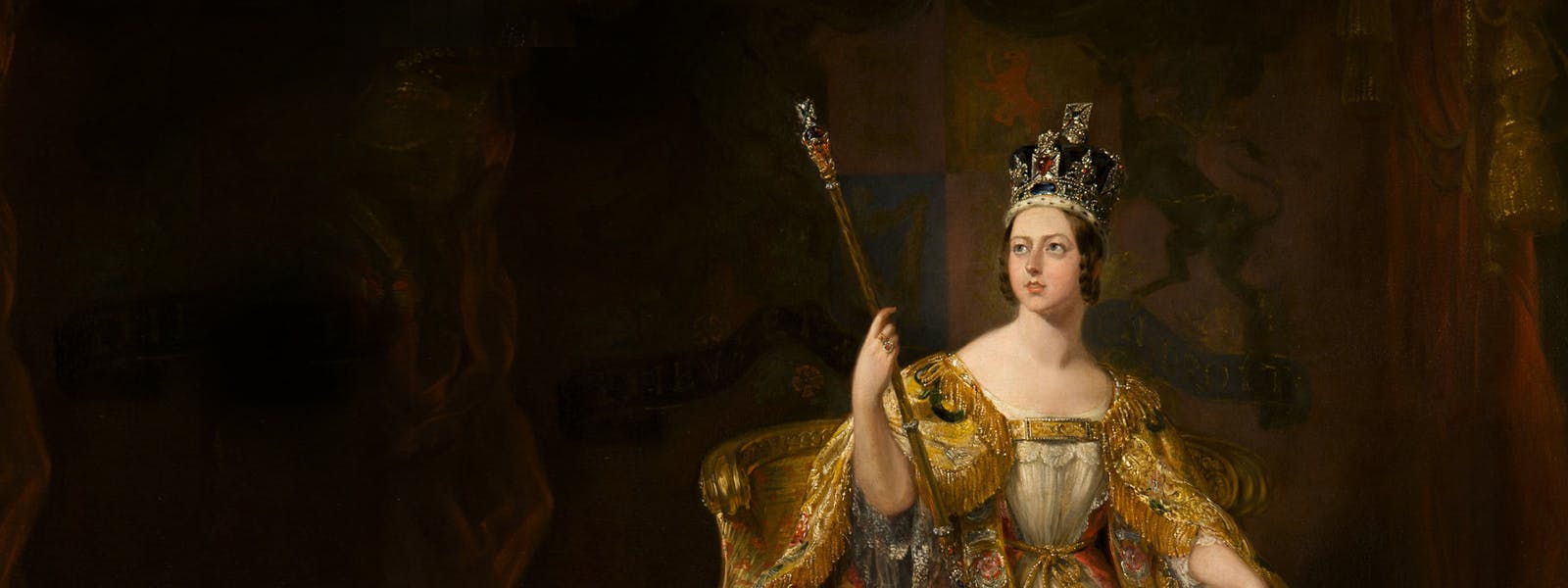
From pampered princess to elderly empress: wife, mother and queen
When the future Queen Victoria was born at Kensington Palace in 1819, she was fifth in line to the throne. However, by the time she was 18, a quick succession of deaths among her relatives accelerated her to accession. She accepted the crown as an inexperienced teenager; when she died, aged 81, she was known as ‘the Grandmother of Europe’.
Although her marriage to her cousin Prince Albert had been ‘arranged’, it was a successful and passionate match, producing nine children and ultimately 42 grandchildren, who married into royal families all over Europe.
Victoria died in 1901 as Queen of Great Britain and Empress of India, although we view the legacy of empire more critically today. The image of Victoria as a stout elderly lady in black mourning endures, despite the complex, multi-faceted nature of the Victorian era and the Queen herself.
Header image: State portrait of Queen Victoria (detail) by Sir George Hayter, RCIN 401213, Royal Collection Trust / © Her Majesty Queen Elizabeth II
Did you know?
Victoria reigned for 63 years, seven months and two days, a reign only surpassed by her great-great-granddaughter Elizabeth II on 9 September 2015.
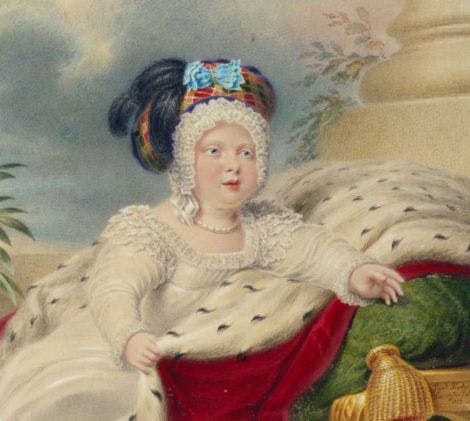
Birth of Princess Victoria
Victoria was born on 24 May 1819 in the dining room at Kensington Palace. It seems a strange choice, but here hot water could be brought up more easily from the kitchens.
At the time of her birth, Victoria’s uncle, the Prince of Wales, was acting as Regent in the final phase of his father's mental illness. The Prince succeeded George III to the throne as George IV in 1820.
Image: Princess, later Queen Victoria (detail) by Johann Georg Paul Fischer, RCIN 914186, Royal Collection Trust/© Her Majesty Queen Elizabeth II
Victoria's route to the throne
By 1818/19, a succession crisis was looming. In 1817, George IV’s only daughter Princess Charlotte had died giving birth to a stillborn son, wiping out two generations of heirs to the throne in one tragic blow. This prompted a desperate ‘baby race’ among the King’s unmarried brothers to produce a legitimate heir.
Edward, Duke of Kent, fourth son of George III, hastily married a German widow, Marie Luise Victoire, Dowager Duchess of Leiningen. She had two children from her previous marriage, one of whom was Princess Feodore, who became Victoria’s much-loved half-sister. William, Duke of Clarence (later William IV) abandoned his long-term mistress to marry Princess Adelaide of Saxe-Meiningen.
The Duke of Kent and his pregnant Duchess rushed back to England, where their daughter was born at Kensington Palace. Their baby daughter, christened Alexandrina Victoria at the palace, took her place as a potential heir to the throne, after her uncle William IV, any of his surviving children, and her own father.
Did you know?
Victoria’s parents considered naming her Elizabeth, Georgina or Charlotte but her uncle George IV had the final say and chose Alexandrina. Victoria was added as an afterthought.
Victoria's Royal Relatives
George IV
Victoria's uncle, George IV was born in 1762, the eldest son of George III. He spent a long time as ‘king in waiting’, acting for nine years as Prince Regent. When he finally acceded to the throne in 1821, he had become spoiled, gluttonous, profligate, highly unpopular and ridiculed in the popular press.
George married secretly (and illegally) a Catholic widow, Marie Anne Fitzherbert, in 1785. Needing a legitimate heir, he was persuaded to marry Princess Caroline of Brunswick in 1795. The unhappy couple quickly produced one daughter, Princess Charlotte, before separating.
Princess Charlotte
George IV's only daughter, Princess Charlotte was a popular princess, seen as a fresh hope to come after her unpopular father. The nation rejoiced at her wedding to Prince Leopold of Saxe-Coburg in 1816.
After suffering two miscarriages, Charlotte became pregnant again. After an excruciating 50-hour labour (during which the doctor, Richard Croft, chose not to intervene) Charlotte was delivered of a stillborn son. She haemorrhaged and died hours later, aged only 21. The tragedy claimed a third life; Dr Croft committed suicide three months later.
William IV
The third son of George III was not expected to succeed to the throne, but the death of his niece Princess Charlotte, followed by his brother Frederick, put him next in line to rule.
In 1790 he met the love of his life, the famous actress Dorothea Jordan and lived with her for the next 20 years, fathering ten children. Dorothea was cruelly abandoned with a pay-off so that William was free to marry Princess Adelaide of Saxe-Meiningen in 1818, 20 years his junior. Their two daughters died in infancy.
The Duke of Kent
Victoria's father, Prince Edward Augustus, fourth son of George III, was sent to Hanover aged 17 for military training. He built up huge debts, and his cruelty in command put an end to his military career. He was posted to Canada where he met Julie de St Laurent, with whom he lived for 30 years.
The succession crisis in 1817 and his need for money meant he abandoned Julie to marry the Dowager Duchess Victoire. He was granted apartments at Kensington, where he lived with wife and baby Victoria until his early death in 1820.
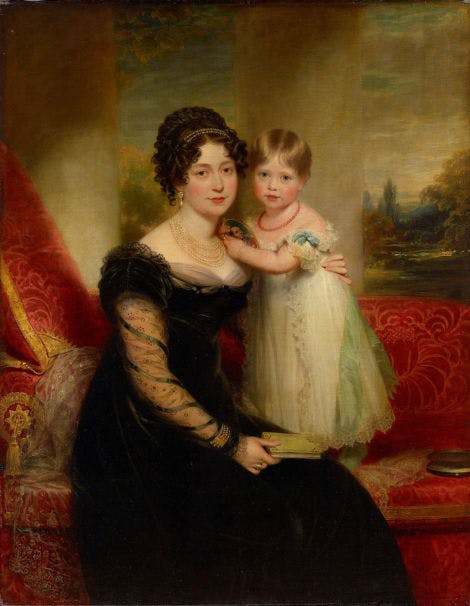
Baby Victoria
The new princess was a strong, healthy baby, described as ‘plump as a partridge’. Unusually for the time, she was delivered by a female doctor, Charlotte Heidenreich von Siebold. This same doctor also delivered Victoria’s first cousin, later husband, Prince Albert.
For her first few months, Victoria was surrounded with love and luxury. The sudden death of her father in January 1820, when Victoria was only 8 months old, and the mass of debt he left behind, changed everything.
Her mother found herself in difficult circumstances.
Her late husband’s equerry, Sir John Conroy, claimed he had been asked by the Duke to take care of the Duchess and became more prominent in the lives of the Duchess and Victoria.
Image: Victoria, Duchess of Kent with Princess Victoria in 1821 by Sir William Beechey, RCIN 407169, Royal Collection Trust/© Her Majesty Queen Elizabeth II
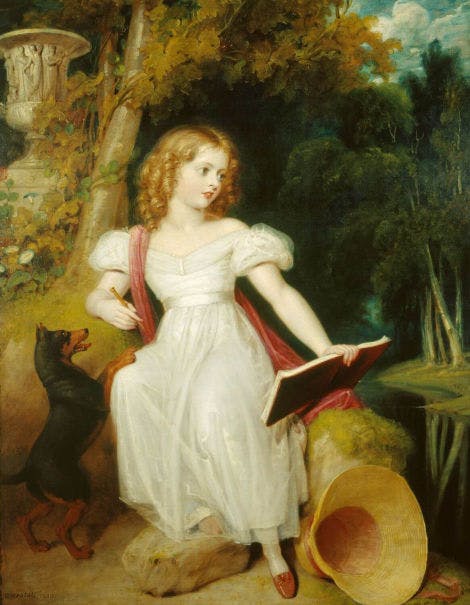
Victoria's early education
From age four, her mother employed the Reverend George Davys, a patient and mild man, who tutored the spirited young princess until she took the throne. She had a singing teacher, Luiga Lablache, an opera singer. The Princess showed a talent for art and was given drawing lessons by Richard Westall, best known for his portraits of Lord Byron.
Victoria later claimed she felt lonely and oppressed during her Kensington Palace childhood, despite the companionship of her beloved governess, Baronness Lehzen. Together they made costumes for Victoria’s collection of dolls, and Victoria wrote stories. Her other great friend and ally was her little dog, Dash. Sometimes she would dress him up in a pair of little trousers.
Image: Queen Victoria when a girl, 1830, by Richard Westall, RCIN 400135, Royal Collection Trust / © Her Majesty Queen Elizabeth II
Listen to the podcast
In the fourth part of this series, we’re taking a walk with curator Claudia Acott-Williams into her favourite space at Kensington Palace, the room where Queen Victoria was born. Claudia will explain how this room was intentionally chosen as the birthplace of the future Queen of England.
More episodesThe Kensington 'System'
The Duchess of Kent, whose English was poor, depended more and more on the help of her late husband’s equerry.
John Conroy was ambitious and controlling and saw an opportunity to grow his influence in the royal household. If Victoria inherited the throne before she was 18, the Duchess would be made Regent. His plan was to bring the Duchess, and Victoria under his control.
He instigated a strict set of rules intended to bolster up the power and position of Victoria’s mother, who was unpopular within the wider Royal family. These rules became known as the Kensington ‘System’.
They meant that Victoria grew up relatively isolated at Kensington Palace, although she was constantly supervised, not even able to walk downstairs without holding someone’s hand in case she fell.
The ‘System’, as it was called, sounds rather cruel. Victoria came to loath Conroy and his attempt to control her.
However, the system worked in her favour.
Because she was rarely at court, Victoria wasn’t associated with her predecessors – her unpopular uncles George IV and William IV.

Influences
Sir John Conroy
Conroy was an officer in the Royal Household Artillery. He had risen quickly through the ranks to become Captain, displaying a talent for creating and implementing systems. He was appointed personal equerry to the newly married Duke of Kent in 1818.
After the Duke’s death in 1820, Conroy seized his chance to act as ‘advisor’ to the bereaved Duchess, who would act as Regent should the infant Victoria accede to the throne.
Sir John Conroy by Henry William Pickersgill, © National Portrait Gallery, London
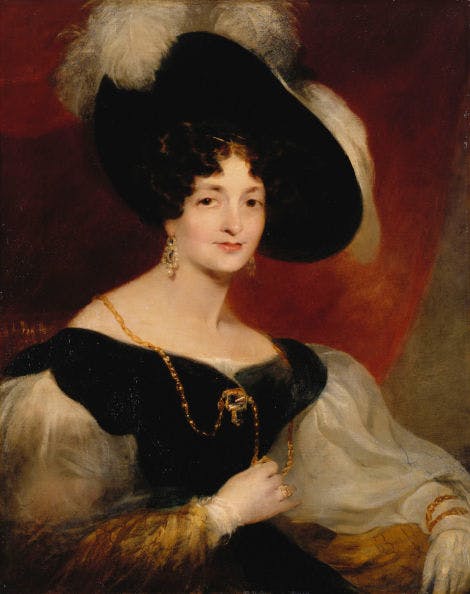
The Duchess of Kent
Victoria's mother, Marie Louise Victoria (known as Victoire) was the Dowager Princess of Leiningen. She was an attractive widow of 32 when she first met the Duke. She was the sister of Princess Charlotte’s widower, Prince Leopold of Saxe-Coburg-Saalfeld. She had two children by her first marriage, Feodore, and Charles.
The Duke’s untimely death left her burdened by his huge debts, alone and vulnerable to John Conroy’s persuasive charm as he stepped in to offer his assistance.
Victoria, Duchess of Kent in 1832 by Richard Rothwell, RCIN 402489, Royal Collection Trust / © Her Majesty Queen Elizabeth II
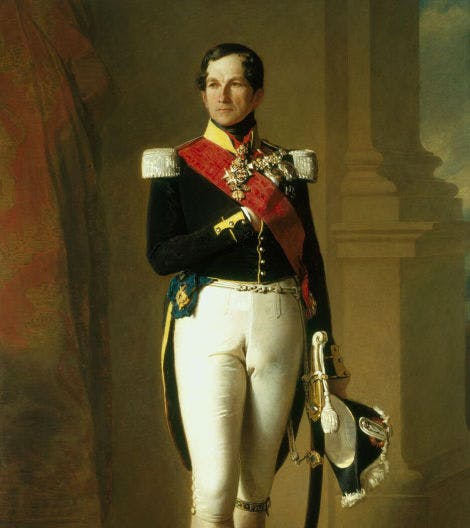
King Leopold
Queen Victoria’s favourite uncle, King Leopold of the Belgians, was a huge influence over her early life. He was a member of the Coburg family and became a British prince when he married Victoria’s cousin Charlotte in 1816.
After Princess Charlotte’s early death, Leopold kept a watchful eye on Victoria. Victoria looked up to him as a father, writing in her diary, ‘He is the best and kindest advisor I have’. It was Leopold who introduced her to his nephew, Prince Albert.
Image: King Leopold I (detail), 1846, by Franz Xaver Winterhalter, RCIN 407284, Royal Collection Trust / © Her Majesty Queen Elizabeth II.
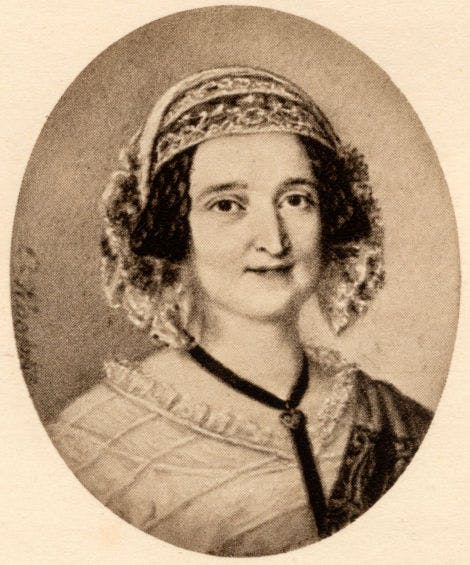
Louise Lehzen
Princess Victoria's ally and support was her devoted, governess, Baroness Louise Lehzen, who had been appointed by the Duchess of Kent and came with her to England before Victoria’s birth.
She was a huge influence on the young Princess’ life and helped her against Conroy.
Victoria kept ‘dear, good Lehzen’ close as a companion and advisor even after she became queen.
Image: Baroness Louise Lehzen, © Classic Image / Alamy Stock Photo
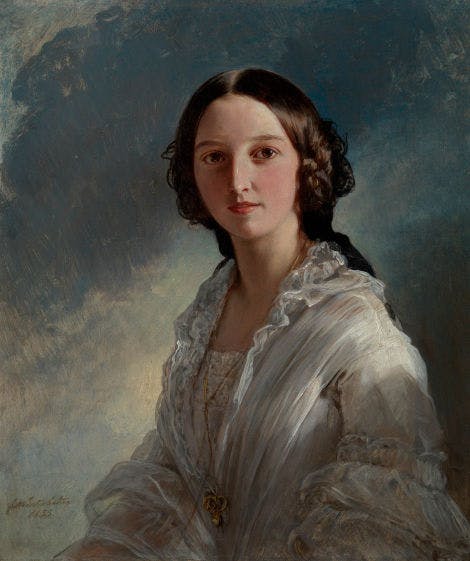
Princess Feodore
For at least part of her childhood, Victoria had the company of her beloved elder half-sister Feodore, until John Conroy arranged to have her married off in 1828 and sent to live in Germany.
Feodore was 11 years older than Victoria. Her brother Charles Leiningen, was 13 when Victoria was born. He lived in the Rhineland, but visited London once a year. He gave the Kensington System its name after hearing all the rules explained to him.
Princess Feodore of Hohenlohe-Langenburg (1839-1872) by Franz Xaver Winterhalter, RCIN 405003, Royal Collection Trust / © Her Majesty Queen Elizabeth II
Victoria's unhappy childhood
While Victoria herself described her childhood as lonely and unhappy, research by Historic Royal Palaces’ curators suggests that in later life, Victoria ‘misremembered’ her childhood as more miserable than it was.
There is evidence her mother doted on her; Victoria enjoyed outings to the seaside, the theatre and her beloved ballet, in truth becoming a bit spoilt and wilful. Victoria herself admitted that she had been spoiled and ‘very much indulged by everyone’.
Did you know?
It’s estimated that Victoria wrote over 60 million words, mainly in her diaries, during her long life.
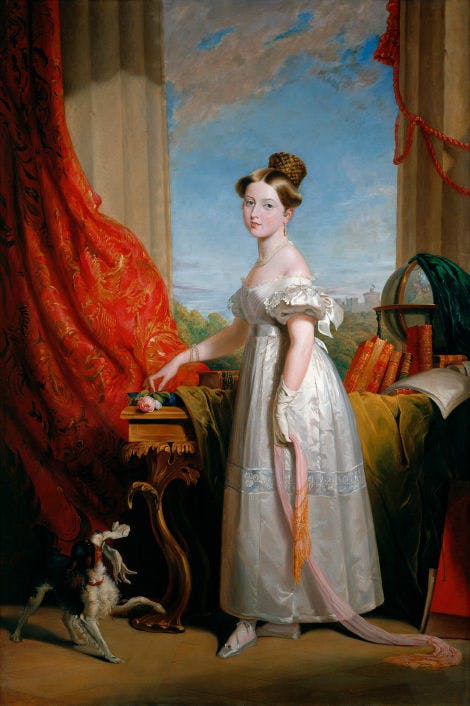
'The Nation's Hope'
The young princess sometimes went on tours around the country.
She recorded many impressions over these tours in her journals, and one of her earliest trips around the Black Country shocked her.
‘The country is very desolate…everywhere smoking and burning coal heaps, intermingled with wretched huts and carts and little ragged children.’
When her uncle the king finally seemed to be at death’s door, her supporters were delighted by the prospect of having a new start for the monarchy.
She was presented as ‘The Nation’s Hope’.
'Victoria was beginning to emerge from the ‘System’ just as Conroy - to give him credit - had intended.' -Lucy Worsley, Chief Curator, Historic Royal Palaces.
Image: Queen Victoria when Princess. At her feet is a spaniel, probably Dash, RCIN 404118, Royal Collection Trust / © Her Majesty Queen Elizabeth II
Victoria becomes queen
At 6am on 20 June 1837, Victoria was woken at Kensington Palace to be told visitors had arrived with important news, which she later described in her diary:
‘I got out of bed and went into my sitting-room (only in my dressing-gown), and alone, and saw them. Lord Conyngham (the Lord Chamberlain) then acquainted me that my poor Uncle, the King, was no more, and had expired at 12 minutes p.2 this morning, and consequently that I am Queen.’
Did you know?
One of Victoria’s first acts as queen was to have her bed removed from the bedroom she had shared with her mother.
First public appearance as queen
Victoria dressed that day in a black mourning dress, in honour of her uncle. Desperate to break free of her mother and Conroy, the 18-year old calmly chose to make her first public appearance as queen without them.
Despite being physically tiny (5ft 1in), her confident manner made a great impression on the men gathered at the Accession Council meeting in the palace’s Red Saloon. As the Duke of Wellington described, ‘she not only filled her chair, she filled the room.’
From this point, Victoria never looked back. She dismissed Conroy and threw off all the shackles of ‘the System’. She moved into Buckingham Palace almost immediately, accompanied by Baroness Lehzen but without her mother, who was sent to live nearby in Belgrave Square. Victoria’s new life had begun.
Did you know?
Some 97 councillors, Cabinet ministers and officials arrived at Kensington Palace and crowded into the Red Saloon for their first meeting with the new queen.
Victoria's coronation
Victoria was crowned on 28 June 1838. Huge numbers of people had flocked to London so the streets thronged with spectators, all eager to catch a glimpse of the young queen.
Although anxious at first, when Victoria looked out of her carriage at all the people cheering, her nerves faded. ‘How proud I felt to be Queen of such a nation’, she later recorded in her diary.
Did you know?
Victoria’s coronation suffered a few mishaps; the coronation ring was forced onto the wrong finger, an elderly peer fell down some steps and a bishop wrongly declared the end of the ceremony.
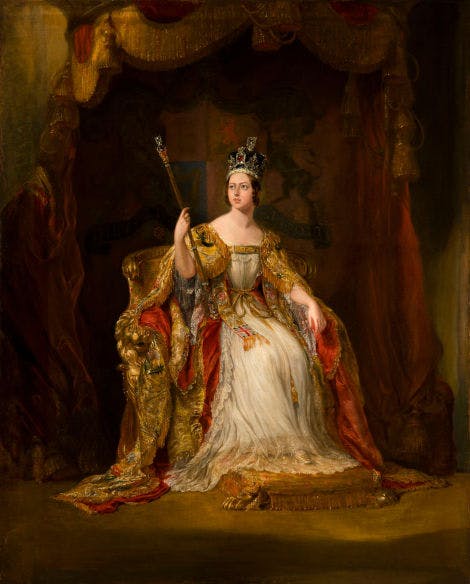
The young Queen
In her first year as monarch, Victoria scarcely put a foot wrong. Her youth meant her new reign was regarded indulgently as people looked forward to a fresh new era. However, her girlish appearance meant that she would be consistently underestimated.
In her own words, she was determined to do a good job. ‘I shall do my utmost to do fulfil my duty towards my country’ she wrote in her diaries. ‘I am very young and perhaps in many, although not all, inexperienced, but I am sure that very few have more real good will and more real desire to do what is fit and right than I have.
Despite her good intentions, the young Queen relied too heavily on some key ministers, principally Lord Melbourne, and made some unfortunate mistakes in the second year of her reign.
Image: State portrait of Queen Victoria by Sir George Hayter, c1838-40, RCIN 401213, Royal Collection Trust / © Her Majesty Queen Elizabeth II

Lord Melbourne
Still just a girl, Victoria leaned heavily on her two most trusted advisors: her uncle Leopold, King of the Belgians, and Lord Melbourne, the Prime Minister.
Victoria hung on Melbourne’s every word, possibly seeing him as a father figure. Despite him being 40 years her senior, they developed a deep friendship, and there were even (unproven) rumours of a romance.
Image: William Lamb, 2nd Viscount Melbourne, 1837, by Sir George Hayter, RCIN 405572, Royal Collection Trust / © Her Majesty Queen Elizabeth II

The Flora Hastings Affair
The Flora Hastings affair demonstrated Victoria’s immaturity and made her temporarily unpopular. Flora was one of her mother’s ladies-in-waiting, and an old friend to John Conroy, which caused Victoria to greatly resent her. When Flora complained of a swollen abdomen in 1839 the royal doctor assumed she was pregnant.
Even worse, Victoria accused her of having an affair with John Conroy, causing her more distress and encouraging gossip. Flora died from a stomach tumour a few months later, and the young Queen was hissed and booed by crowds outside Buckingham Palace.
Image: Lady Flora Hastings, © Pictorial Press Ltd / Alamy Stock Photo
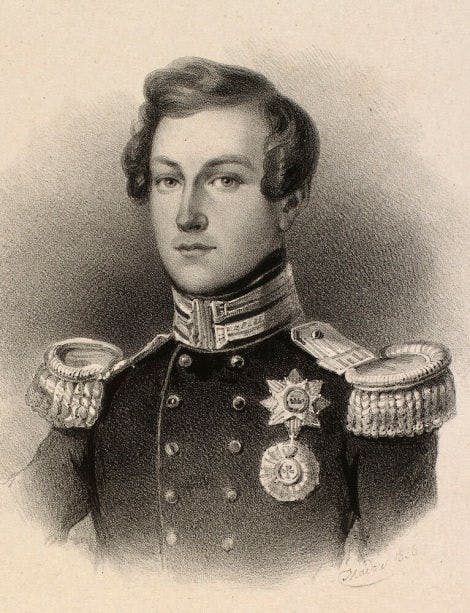
Prince Albert and the proposal
Victoria had first met her German cousin Prince Albert in 1836, when he and his brother Ernest visited Kensington Palace with their Uncle Leopold, King of the Belgians. Their families had planned a union almost from birth, and when the couple met again in 1839 Victoria decided that she was ready to marry this handsome young prince; partly to get help with her royal duties, partly to win public approval, but also for love.
As protocol demanded, Victoria proposed on 15 October 1839. When Albert accepted, the couple embraced and the Queen was overcome with joy. ‘Oh how I adore and love him, I cannot say!’ she wrote in her diary.
Image: Prince Albert of Saxe-Coburg and Gotha, 1836, RCIN 2506467, Royal Collection Trust / © Her Majesty Queen Elizabeth II
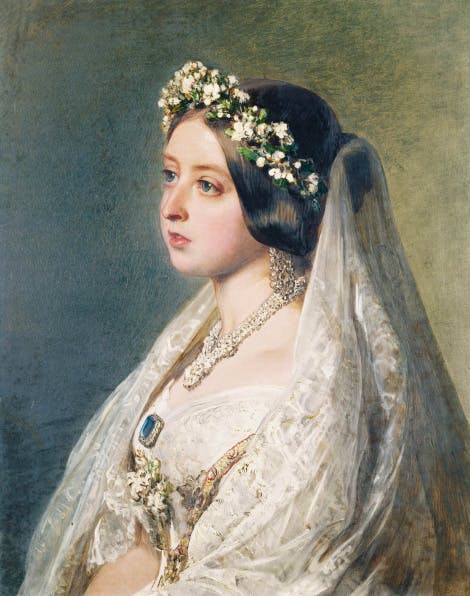
Victoria weds Albert
Victoria’s wedding in 1840 to Albert was very public. It was the first royal marriage ceremony to be arranged with the enjoyment of the London public in mind. She travelled to the Chapel Royal at St James’s Palace in an open carriage so that everyone could see her.
To show that she was a woman as well as a queen, Victoria wore a simple white dress instead of royal robes, a style followed by many brides ever since.
Victoria’s wedding – the white dress, the carriage ride through the streets, the very public nature of it – set the pattern for every subsequent marriage ceremony in the main line of descent within the royal family.
For her marriage to Albert, Victoria chose a fashionable white satin court dress. As there were so many guests in the Chapel Royal, ladies had been requested not to add court trains to their dress to relieve the congestion. The bride’s procession entered to a fanfare of trumpets, with Lord Melbourne at its head. The Princess was supported by her uncle the Duke of Sussex in place of her late father.
Image: Queen Victoria depicted in her wedding dress and veil with orange blossom wreath. She wears the brooch made for her by Prince Albert, and earrings and necklace of Turkish diamonds, RCIN 400885, Royal Collection Trust / © Her Majesty Queen Elizabeth II
Their short honeymoon was a success and three days after her wedding she wrote in her journal: 'My dearest Albert put on my stockings for me. I went in and saw him shave; a great delight for me'.
Victoria and Albert always presented themselves to the world as a loving couple. But they did sometimes have terrible rows early in married life when their roles and responsibilities were unclear. For example, Albert wanted to choose his own staff, while Victoria insisted he accept her choices, and he was forced to give way.
The official portraits of Victoria and Prince Albert were the first to be commissioned from the German artist Franx Xaver Winterhalter, who would become their favoured contemporary painter.
Married life
Albert was no different from many men of his age, who assumed that a man would take the dominant role in a marriage. Wider attitudes were changing as to what made a successful marriage: a writer at the time counselled her female readers that a happy relationship was founded on one important truth ‘the superiority of your husband as a man’.
The Queen’s first pregnancy in 1840 helped ease the situation. When she was not feeling well enough Albert read her daily Government despatches to her. As her pregnancy progressed they placed their desks side-by-side at Buckingham Palace so they could work together. Gradually Albert assumed more control, becoming, in effect, Victoria’s Private Secretary.
Did you know?
By 1845, Albert was advising the Queen to such an extent that the diarist Charles Greville wrote ‘They are one person. And He likes and She dislikes business.’
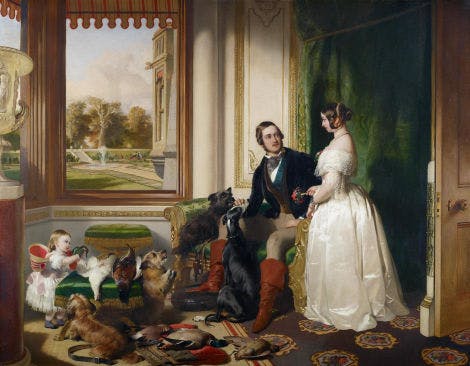
Victoria and Albert's children
Victoria and Albert were delighted by the arrival of Princess Victoria - ‘Vicky’ - born in 1840.
Athough Victoria wrote that she found pregnancy difficult, a large family was her ambition. Vicky was followed by Albert Edward (later Edward VII) in 1841, then Alice (1843), Alfred (1844), Helena (1846), Louise (1848), Arthur (1850), Leopold (1853) and Beatrice (1857).
Image: Queen Victoria, Prince Albert and Victoria, Princess Royal 1841-43, RCIN 406903, Royal Collection Trust / © Her Majesty Queen Elizabeth II
The royal parents
Victoria and Albert shared an interest in raising and educating their nine children and presented a happy family image to the world. Unlike many aristocratic fathers of the period, Albert enjoyed playing with his children and spent a lot of time with them. ‘He is so kind to them,’ Victoria wrote, ‘& romps with them delightfully.'
Holidays and birthdays were marked with great excitement, with scenes of joyful domestic Christmases, masterminded by Albert, appearing in the new illustrated newspapers to great public delight.
Did you know?
Victoria had marble sculptures made of her children’s hands and feet, from plaster casts taken while they were asleep.
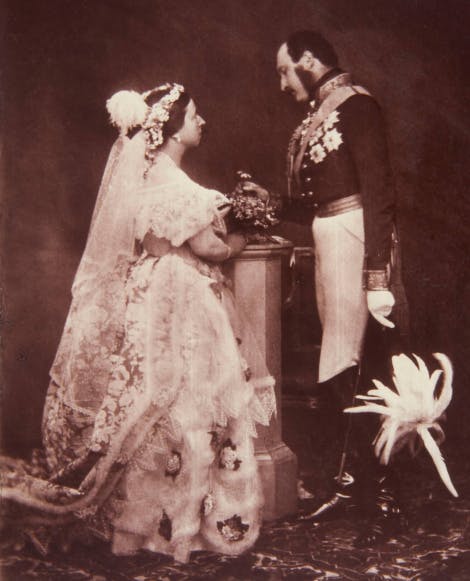
Albert takes charge
Victoria could see that her subjects would approve if she devoted herself to her children and let Albert take over some of her royal duties.
He was determined to carve out a uniquely powerful role as Prince Consort, taking charge of many of his wife’s commitments.
Albert became obsessed that Baroness Lehzen was influencing his wife, so persuaded Victoria to ‘retire’ her old governess back to Germany.
Without Lehzen, and her dear friend former Prime Minister Melbourne (who died in 1842), the Queen became totally dependent on Albert.
Image: Queen Victoria and Prince Albert in court dress, 1893 (copy of an image from 1854), RCIN 2906084, Royal Collection Trust / © Her Majesty Queen Elizabeth II

Princess Victoria ('Vicky')
Victoria and Albert’s eldest child (and Albert’s favourite), Vicky, was married at 16 in 1875 to a Prussian Prince, Frederick Wilhelm, ‘Fritz’, the man who’d become Kaiser of Germany.
Vicky had a hard life in Germany. As tension deepened between the countries of her husband and her mother, she became very unpopular.
Image: Empress Friedrich, when Crown Princess of Prussia, 1862, image taken by her brother Prince Alfred, RCIN 2900552, Royal Collection Trust/© Her Majesty Queen Elizabeth II

Edward VII ('Bertie')
Victoria’s second child, the all-important male heir Albert Edward, or ‘Bertie’ to his family, often disappointed his mother by what she saw as a lack of seriousness and of application.
In fact, he had an easy manner and for a flair for magnificent public events that would make him a popular successor to his mother. Bertie married Alexandra, Princess of Denmark in 1863.
Image: King Edward VII when Prince of Wales, 1860, © National Portrait Gallery, London
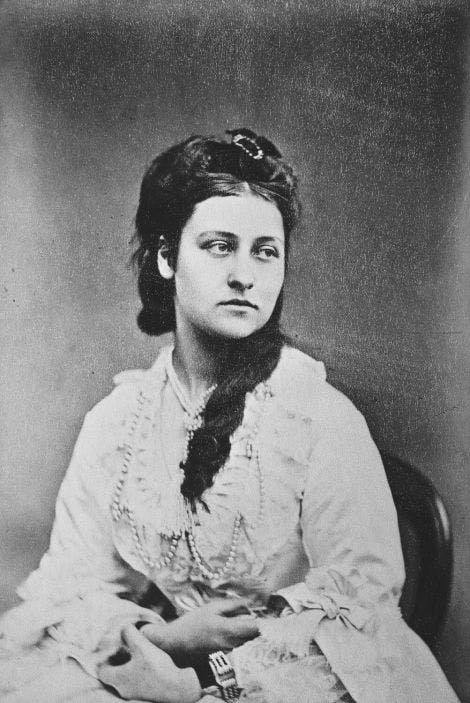
Princess Louise
Among Victoria’s other children, Louise particularly intrigues people today. She was highly creative, a supporter of education for girls, and married to a commoner rather than to another royal.
Beautiful, artistic Louise was never far from some scandal or gossip. Many believed her husband, the Marquess of Lorne, was homosexual and Louise compensated by an affair with her tutor, the sculptor Edward Boehm, who died suddenly of a heart attack while Louise was present in his studio.
Image: Princess Louise in 1871, RCIN 2902341, Royal Collection Trust/© Her Majesty Queen Elizabeth II
Queen Victoria's world
Victoria and Albert’s family grew up against a backdrop of a world marked by radical and unprecedented change. Her reign ushered in an era of huge advances in technology and legendary feats of construction.
It was an age of innovation. Fabulous construction such as the Clifton Suspension Bridge, the world’s first, was built by Isambard Kingdom Brunel and completed in 1864.
London was the first city to open a steam-powered single line multi-station underground railway in 1863, designed by John Fowles.
Britain was a bustling, commercial, prosperous place, although with a shocking dark underworld of poverty, pollution and slums.
Despite a punitive system of punishment and harsh poverty laws, murder, rape, prostitution, theft, widespread begging and terrorism, were all part and parcel of Britain’s frenetic development in the 19th century.
Victoria herself was deeply socially conservative and thought that people should stay in the social classes into which they were born.
She once said that the idea of giving women the vote was a ‘mad and wicked folly’.
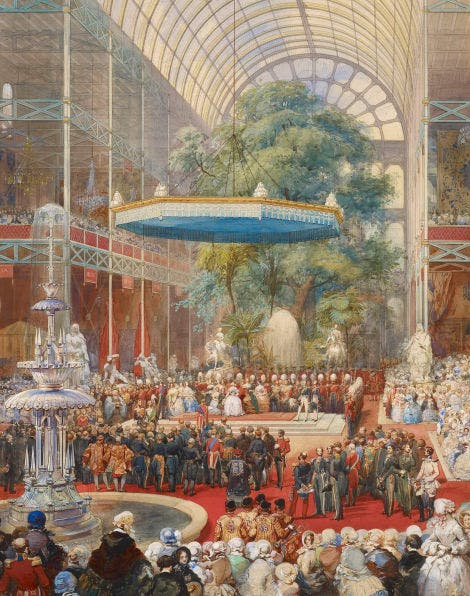
The Great Exhibition
At the other end of the scale from the tough lives of working people was the celebration of technological innovation and the expansion of trade and British interests.
Prince Albert was a highly intelligent man, with a social conscience, interested in trade, industry, art and science.
In 1851 he organised the massively successful Great Exhibition, with over 100,000 exhibits from all over world, including the famous Koh-i-Nûr diamond.
Image: The opening of the Great Exhibition in 1851, RCIN 452380, Royal Collection Trust / © Her Majesty Queen Elizabeth II
A show of industry and culture
Victoria was so fascinated by her husband’s achievement that she visited the exhibition nearly every day for three months. Entrance tickets were cannily varied in price and ranged from a top price season ticket of 3 guineas ‘for gentlemen’ – equivalent to more than £2,000 today – down to a day ticket priced at one shilling.
For her, as for millions of her subjects who would never travel abroad, it was an opportunity to explore the whole world in a day. By the time the exhibition closed, it had attracted over 6 million visitors.
Did you know?
Albert chose a bright pink dress for Victoria to wear to the exhibition opening so that she would stand out against the crowds.

Death of Prince Albert
Sadly for Victoria, the person she depended on for strength and support would soon leave her. In 1861 Victoria two suffered great losses, that shocked her to the core.
First, her mother died in March, but worse was to come. Later that year, her beloved Albert fell ill and died on 14 December 1861, aged only 42. Victoria was devastated.
She wrote to her uncle Leopold: 'The poor fatherless baby of eight months is now the utterly broken-hearted and crushed widow of forty-two! My life as a happy one is ended! The world is gone for me!'
Just three weeks after Albert's death in 1861, Victoria held a Privy Council meeting. She was so grief-stricken she could not utter a word.
Image: Photograph of Prince Albert (detail), taken months before his death. RCIN 2906892, Royal Collection Trust / © Her Majesty Queen Elizabeth II
Victoria in mourning
Victoria plunged into a deep grief, from which she never totally recovered, and wore black for the rest of her life. Her sharp withdrawal from public life lasted for over ten years, and was disastrous for her public image.
Albert’s death left Victoria very lonely. She insisted on her children spending a lot of time with her, and she almost obsessively kept the memory of their father alive.
Did you know?
The Queen wore more restrained jewellery after Prince Albert's death. Jet black accessories complemented her usual mourning attire.

A grieving family
For this wedding photograph celebrating the marriage of The Prince of Wales to Princess Alexandra of Denmark in 1863, the Queen insisted the group was posed around a bust of her beloved Albert.
Image: Family portrait with bust of Prince Albert, 1863, John Jabez Edwin Mayall, RCIN 2927091, Royal Collection Trust / © Her Majesty Queen Elizabeth II
The Widow of Windsor
The Queen’s withdrawal from public life into seclusion caused wider problems. People began to assume that she was incapable of doing her job. In the years following Albert’s death, it seemed that she had become paralysed with grief.
Victoria lost the confidence to appear in public, retreating behind the walls of Windsor Castle to the disappointment, and the increasing disrespect, of her subjects. There were even calls for the abolition of the monarchy. However, two men helped her recover in the years that followed.
Did you know?
Victoria was so badly affected by Albert’s death that her doctors feared she was seriously mentally ill, and her self-imposed seclusion was described as ‘evidence of insanity’.

John Brown
Victoria became close to her plain speaking ‘Highland servant’, John Brown, after Albert’s death in 1861. She described his constant presence as ‘a real comfort’.
Brown treated her kindly but firmly, as a woman rather than a monarch and slowly he helped her recover from her intense grief. His influence with the Queen made him highly unpopular within the royal household, which Victoria ignored.
Image: Queen Victoria with John Brown at Osborne, 1865-67, RCIN 403580, Royal Collection Trust / © Her Majesty Queen Elizabeth II
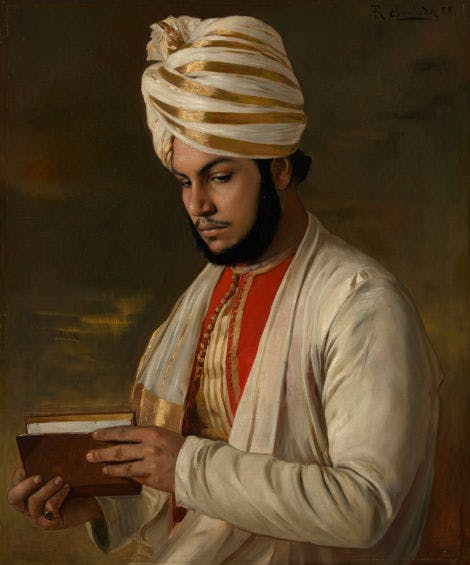
Abdul Karim
In 1887, Victoria again angered the court by making a close favourite of her personal servant from India, Abdul Karim. As with John Brown, Karim attracted jealousy and prejudice, particularly because of his ‘low’ social background.
But Victoria did not listen to what people said, and went on in her own way.
Abdul Karim’s job as ‘Munshi’ (teacher) was to teach her the language of Urdu, in which she became fluent, and her notes from her lessons still survive.
Image: Queen Victoria with Mohammed Abdul Karim at Balmoral, c1890, RCIN 403831, Royal Collection Trust / © Her Majesty Queen Elizabeth II
Victoria and empire
In the latter part of her life, the Queen became particularly involved in promoting the expansion of the Empire, until by the end of the reign it covered more than one-fifth of the world’s land mass, including the whole of the Indian subcontinent, large parts of Africa, and colonies in the Caribbean.
However, the British Empire’s gain represented a terrible loss for other nations and peoples, and towards the end of Victoria’s reign, her empire was almost constantly at war.
Did you know?
Between 1815 and 1914, around 10 million square miles and 400 million people were added to the British Empire, until nearly one in four people on earth were under colonial rule.

Empress of India
Victoria was crowned Empress of India on 1 May 1876, although her involvement had begun years before then.
By the 1840s she was appalled by the behaviour of the East India Company, who ran the British territories in India.
In 1856 she wrote, ‘I always feel sorry for those poor deposed Indian Princes.’
Although she was fascinated by all things Indian, she never visited the country, which is perhaps why she found it possible to shut her eyes to some unpalatable facts.
She was, for example, happy to wear the Koh-i-Nûr diamond, seized by the British in 1842 during the Anglo-Sikh Wars.
State portrait of Queen Victoria in 1885. She wears the ribbon and star of the Garter with the badges of the Order of Victoria and Albert and the Crown of India. RCIN 403405, Royal Collection Trust / © Her Majesty Queen Elizabeth II
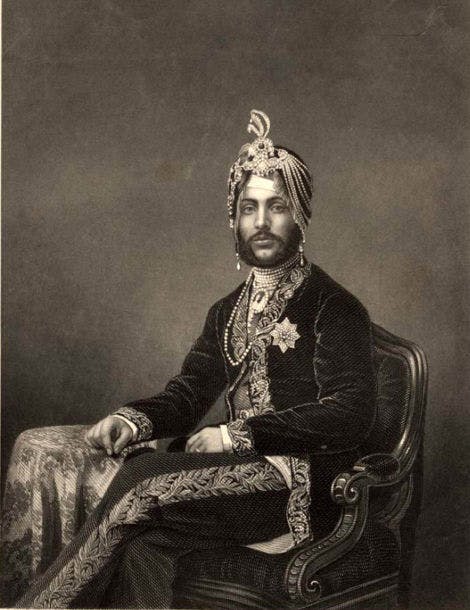
Duleep Singh
This young Indian prince, who was invited to meet Victoria and Albert in 1854 at Osborne House, was the last Maharaja of the Sikh Empire. He was deposed in 1848 by the British, and he was required to surrender the famous Koh-i-Nûr diamond to Queen Victoria.
In 1853 he converted to Christianity and a year later was invited to England, where he lived in Suffolk. He married Bamba Müller, with whom he had seven children. In later life, the Maharaja tried to reinstate himself to the throne of Lahore but he was arrested. He was finally reconciled with Victoria who gave him a full pardon in 1890.
Image: Duleep Singh, c1860s, © The History Collection / Alamy Stock Photo
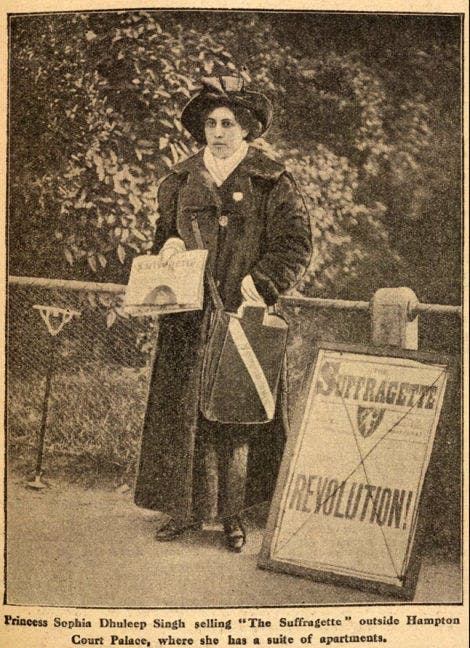
Sophia Duleep Singh
Duleep Singh and Bamba Müller's daughter, Princess Sophia Alexandrovna Duleep Singh (1876-1948) was a prominent English suffragette. Queen Victoria became her godmother, although the Queen would have been scandalised by Sophia’s political beliefs and actions as an adult.
The Princess campaigned vigorously for female suffrage. She became a familiar figure selling political newspapers outside Hampton Court Palace, where the Queen had allowed her family to live.
Image: Sophia Duleep Singh. © Historic Collection / Alamy Stock Photo

Sara Forbes Bonetta
Sara, whose real name was Aina, was a West African Egbado princess of the Yoruba people. She was orphaned in intertribal war, sold into slavery, liberated and became goddaughter to Queen Victoria.
She was named by Captain Frederick Forbes after his ship, the Bonetta. He obtained her release by suggesting that she be given as a ‘gift’ to the Queen of England. He took her back to England and she was presented to Victoria in 1850.
Victoria oversaw her education (Sara was exceptionally gifted) and gave her an allowance for her welfare, and Sara became a regular visitor to Windsor Castle. In 1862 she married a Yoruba businessman and moved back to West Africa to settle in Lagos.
Image: Sara Bonetta Forbes in 1856, RCIN 2800762, Royal Collection Trust / © Her Majesty Queen Elizabeth II
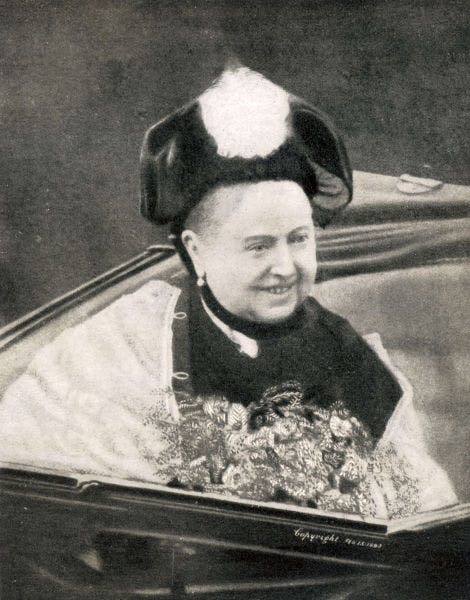
Victoria's Diamond Jubilee
The Queen's splendid Golden Jubilee in 1887, and even more magnificent Diamond Jubilee in 1897 helped restore her popularity after her retreat from public view following Albert’s death. The excitement around the celebrations in 1887 brought renewed vigour to her image but she couldn’t forget her private grief, writing, ‘The day has come, and I am alone’.
By 1897 she was more confident of the people’s affection for herself and for the monarchy; she was seen as the nation’s ‘grandmother’. Victoria sent a telegraph message to the world thanking her subjects for their loyalty: ‘From my heart I thank my beloved people. May God bless them!’ She received thousands of congratulatory messages from all over the world.
Image: Rare photograph of Queen Victoria smiling, 1887, © Chronicle / Alamy Stock Photo
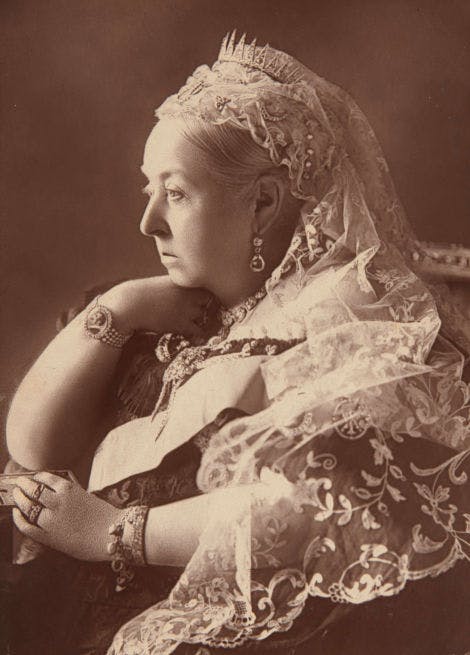
Death of Queen Victoria
By 1901, Victoria had grown very frail and had to use a wheelchair. She was losing weight, she ‘had lost so much flesh and had shrunk so as to appear about one half the person she had been’.
Her surviving dresses from this period reveal adaptations to accommodate an osteoarthritic hump on her upper back.
Although nearly blind, she continued to write in her diary. The last entry was dated 13 January 1901, before her strength began to leave her.
As her life ebbed, her first grandson, Wilhelm II, King of Prussia, (‘Kaiser Bill’), rushed from Germany to be by her side. She died in his arms, on 22 January at Osborne House, Isle of Wight.
Image: Portrait of Queen Victoria, commissioned for her Diamond Jubilee in 1897. The Queen wears a white veil and crown and a bracelet with a portrait of Prince Albert. © Historic Royal Palaces
The Queen's last wishes
The Queen’s body was brought back to London and crowds lined the streets as her funeral cortege passed on its way to her final resting place, St George’s Chapel, Windsor.
Victoria had asked for certain items to be placed beside her in her coffin, including rings, lockets, casts of the children’s hands and Albert’s dressing gown.
Did you know?
She also asked her trusted royal doctor to hide a photograph of John Brown and a lock of his hair in her left hand.

Victoria's funeral
The Queen had wanted her funeral done ‘with respect but simply’. Here, royal mourners follow the Queen's coffin on its gun carriage (with wheels muffled as she had requested) through the High Street on the way to St George's Chapel in Windsor Castle.
King Edward VII walked in the centre behind her coffin. On his left is Victoria’s third son Prince Arthur and on the right of the King is Kaiser Wilhelm II.
Image: RCIN 2510238, Royal Collection Trust / © Her Majesty Queen Elizabeth II 2019
Queen Victoria's legacy
Victoria was a skilled politician who presented herself as a devoted wife, doting mother, and grieving widow, which made her home-loving Victorian subjects love her.
By the time of her Diamond Jubilee, in 1897, no one could doubt that a woman was capable of reigning.
Her continued presence during such a period of intense period of technological, economic and social change had helped place the monarchy at the centre of the nation’s identity.
It’s thanks to Queen Victoria that we can enjoy visiting her birthplace of Kensington Palace, which she opened to the public in 1899.
The rooms that she grew up in provide a fascinating glimpse into her former life. The statue of her, created by her daughter Princess Louise and unveiled in 1893, still stands outside the palace today.
Victoria had already opened Hampton Court, a palace in which she never lived, to visitors in 1839.
Many Victorians admired their queen’s reign for its stable government at home, and enormous expansion abroad. Since then, her descendants, and the descendants of her subjects, have been left with a feeling that Victoria’s reign was a time when Britain was truly great.
But historians today are much quicker to count the cost of that ‘greatness’, particularly to the non-British subjects of the Empire.

Grandmother of Europe
Victoria had also hoped, through the marriages of her children into the other royal families of Europe, to create a network of alliances that would keep Europe peaceful.
Between them, her children gave her 42 grandchildren, and by the turn of the 20th century, her grandchildren were on the thrones of Denmark, Greece, Norway, Germany, Romania, Russia and Spain.
This was a strategy doomed to failure, and it was Victoria’s own grandson, Kaiser Wilhelm II, who led Germany into war against Britain in 1914.
Queen Victoria and family at Coburg on 21 April 1894. Sitting with the Queen in the second row is Kaiser Wilhelm II (left). Tsar Nicholas of Russia stands immediately above him with Tsarina Alexandra. The Prince of Wales, later Edward VII, stands immediately above Tsar Nicholas. RCIN 2905204, Royal Collection Trust / © Her Majesty Queen Elizabeth II 2019
BROWSE MORE HISTORY AND STORIES
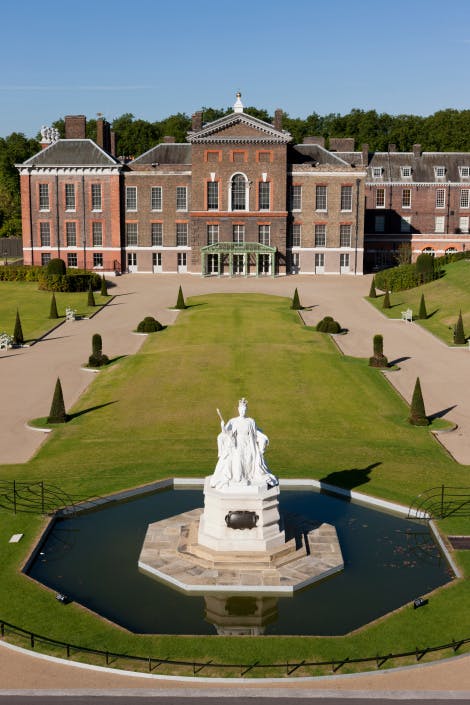
The story of Kensington Palace
An elegant retreat for Britain's royal family
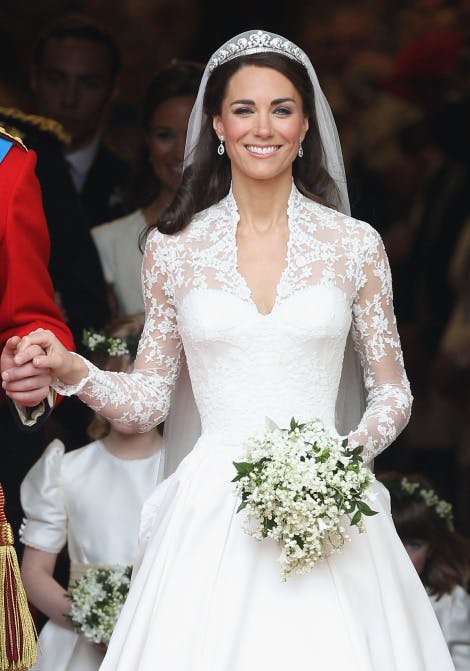
A history of royal weddings
From Queen Victoria to the modern royals
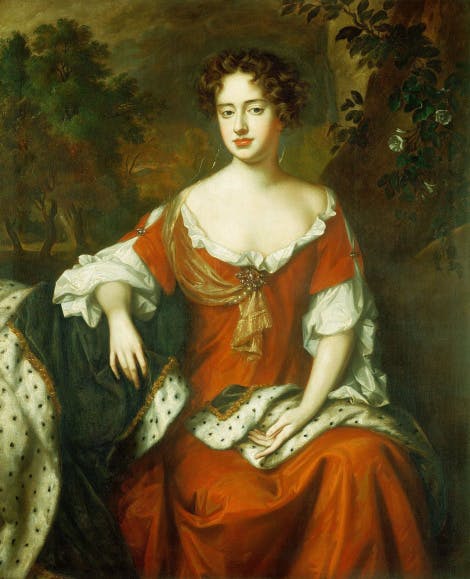
Queen Anne
A surprisingly successful monarch, despite ill health and tragedy
EXPLORE WHAT'S ON

- Things to see
- Exhibition
Untold Lives
A new exhibition at Kensington Palace, uncovering the forgotten stories of those who worked at the royal palaces over 300 years ago.
- Until 27 October 2024
- In line with palace opening hours
- Kensington Palace
- Included in palace admission (members go free)

- Things to see
The Palace Gardens
Walk in the footsteps of royalty in the beautiful Kensington Palace gardens.
- Open Daily
- 10:00 - 18:00
- Kensington Palace
- Free

- Things to see
The King's State Apartments
Wander through the lavish rooms of the King's State Apartments, each one grander than the last, at Kensington Palace.
- Open Wednesday - Sunday
- In line with palace opening hours
- Kensington Palace
- Included in palace admission (members go free)
Shop online
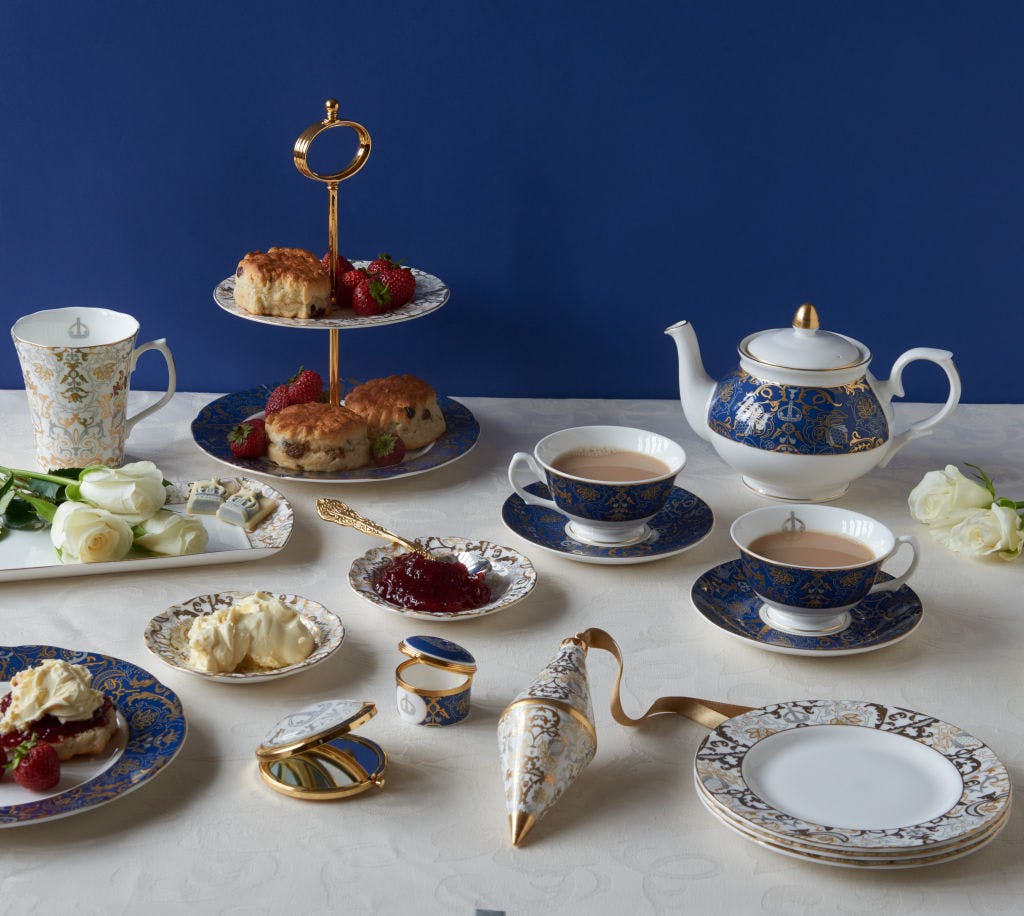
Shop Queen Victoria gifts
Exclusively designed for Historic Royal Palaces, our Queen Victoria gifts are inspired by iconic symbols from Queen Victoria's reign.
From £2.50
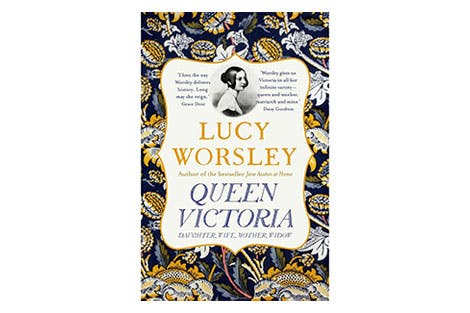
Queen Victoria: Daughter, Wife, Mother, Widow
Lucy Worsley showcases Queen Victoria's life through 24 key days. Through diaries, letters and more, we discover a personal and close up view of Victoria's life and see the very heart of her reign.
£10.99
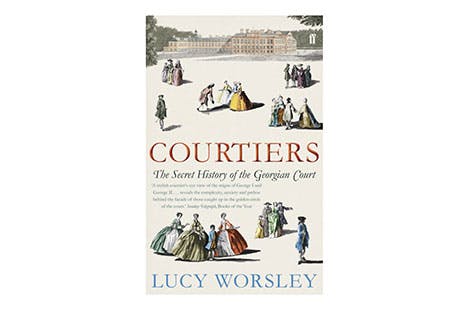
Courtiers: The Secret History of Kensington Palace
Told through the eyes of a courtier, this fascinating book explores the ambitious and talented people who flocked to the Georgian court in search of power and prestige.
£12.99

